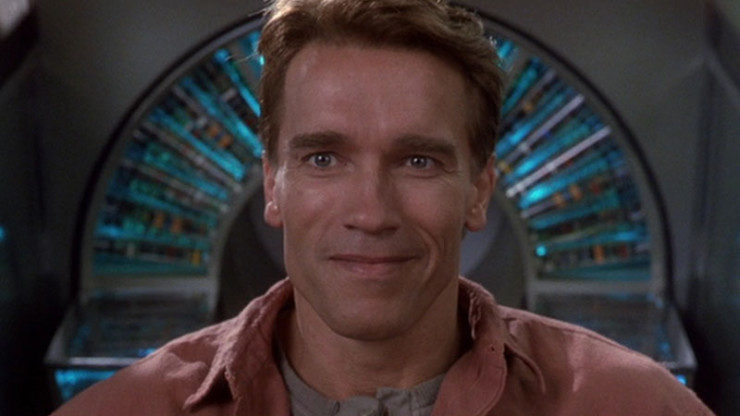Freedom is a terrifying thing. Even within the limit-breaking world of cyberpunk, we’re often afraid to embrace it.
Our twitchy heroes stand up to humanity-enslaving machines, tyrannical AIs and the necrotic touch of megacorperations. But when it comes to gender and sexuality, why do so many cyberspace-dancing, body-hopping protagonists cling to the confines of conservative sexuality and gender?
As Michelle Chilcoat points out in “Brain Sex, Cyberpunk Cinema, Feminism, and the Dis/Location of Heterosexuality,” we see quite a lot of norm-shackled characters in our reality-tripping sci-fi. In Total Recall, Schwarzenegger’s Quaid strongly proclaims his hetero orientation as a programing note for his memory-implant vacation—and experiencing the whole adventure as anything but his hyper-masculine self doesn’t even seem to be an option. Instead of asking the Rekall tech to program in a pansexual transhumanist awakening, he chooses the sexual equivalent of doppling into an anteater.
Sure, we might expect such things from ’90s Paul Verhoeven, but it’s not like Kathryn Bigelow’s Strange Days or even the Wachowskis’ Matrix films did much of anything to buck the trend (or were not permitted to by studio heads). Granted, we’re talking big Hollywood productions here, and even today cyberpunk-flavored mainstream projects are loath to do something so edgy as cast an Asian lead—much less force the audience to consider what could happen in a world where technology transmutes our experience of self and reality. Is that the safety we crave from our cyberpunk? Like a Reagan-era Queen fan, do we belt out “I Want to Break Free” in the shower, only to recoil in horror when MTV airs the music video?
It’s impossible to consider any of this without dipping into the cyborg feminism of Donna J. Haraway, who used the cyborg as a metaphor for the modern human unbound by binary identities, prescribed norms and the limits of natural/unnatural—or, indeed, male/female, Arnold/Sharon Stone or Neo/Trinity. We all have the power to become who and what we want to be.
Cyberpunk should be rife with such revolutionary beings, right?
Assuming I’m not missing something big (and by all means, please chime in below if I am), we’ve yet to have that cyberpunk cinematic experience that embraces the “punk” in an unabashed queercore sense of the word—and maybe that’s a lot to ask. Certainly, we’ve seen numerous, wonderful examples of sexual and gender fluidity in sci-fi literature over the years—especially in far-future, transhuman worlds. But even literary cyberpunk is often lacking in this department.
A few standouts come to mind. Melissa Scott’s 1994 novel Trouble and Her Friends is probably the most famous cyberpunk work to challenge masculine, heteronormative leanings. Other works exist in its orbit, but it was rather groundbreaking at the time. And while not overtly cyberpunk in nature, Victor Pelvin’s The Sacred Book of the Werewolf raises some of the possibilities of virtual worlds as the adventurous A. Hu-li tries to convince her unimaginative lover Alexander that they should make shared-dream love as a tentacled sentinel and an Armored Personnel Unit from The Matrix Revolutions. Like the average cyberpunk male, however, Alexander wants no part of the fantastic.
Richard K. Morgan’s splendidly gratuitous Altered Carbon features one of the more imaginative transhuman sex scenes ever written, and yet the body-hopping Takeshi Kovacs sticks to male-centered heterosexuality. As I recall, his consciousness only ever sleeves inside a female body at the behest of his torturers. You can probably contribute these choices to the series’ noir DNA, and Morgan certainly had no qualms about including a complex gay character and more than a little gay sex in his A Land Fit For Heroes dark fantasy trilogy. But we can only hope the upcoming Netflix adaptation of Altered Carbon considers the true Haraway-esque cyborg possibilities for a hard-boiled, brooding body-hopping mercenary in a world of sexual excess.
Still, cyberpunk is an ever-expanding genre. What are your favorite examples of gender and sexual fluidity within the cyberpunk genre? For that matter, feel free to roll out the more outrageous examples of uber-masculine heteronormative heroics—to say nothing of the occasional cliché lesbian and oh-so-reckless bisexual to remind us how non-threateningly edgy things are in Grungy Tech City.
And for those of you who write and dream beneath a TV-colored sky: allow your characters to fall in love, break free, and ride that ICE beyond the limits of prescribed norms.










